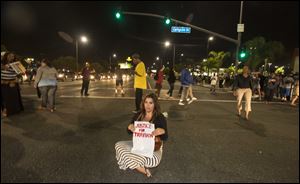
Ohio House resurrects ‘stand your ground’ bid
7/21/2013
A demonstrator with a sign sits on the intersection of Crenshaw Boulevard and Coliseum street during a protest in Los Angeles on Sunday, July 14, 2013, the day after George Zimmerman was found not guilty in the shooting death of Trayvon Martin.
A bill pending in a legislative committee would make Ohio the latest state with a “stand-your-ground” law, even as rallies are planned in Toledo and across the nation today to protest last week’s acquittal of George Zimmerman in the death of Trayvon Martin.
Buried in House Bill 203, the latest effort to loosen restrictions on the carrying of concealed handguns, is a provision that would broaden Ohio law that presumes someone acted in self defense if he feels he or family members are in imminent danger and shoots an intruder in his home or car.
“It is a mistake to require a person to turn their back on their assailant to try and flee,” the bill’s sponsor, Rep. Terry Johnson (R., McDermott), said during a June hearing. The Republican-controlled General Assembly has since recessed for the summer and won’t take up the measure until September at the earliest.
“If I was out with my family, and we were attacked, I would want to be able to defend them,” said Dr. Johnson, a Cincinnati-area physician. “The person will still have to show in a court of law that they were acting in self defense, and we are making no changes to the threshold a person has to meet to demonstrate self defense in a court of law.”
The legislation would expand the circumstances under which lawful Ohio gun-owners have no legal duty to retreat when assaulted before using potentially deadly force to defend themselves to any “place that the person lawfully has a right to be.”
Jonathan Fulkerson, deputy chief counsel for Ohio Attorney General Mike DeWine, offered as examples of exceptions burglars or intruders on private property as well as persons prohibited from being in certain places by court-issued protection orders.
He hesitated to say expanding the “no duty to retreat” provision would give Ohio a stand-your-ground law. “There is no uniform ‘stand-your-ground’ law. It’s not a legal label; it’s more of a popular-culture label,” he said.
In Florida, attorneys for Mr. Zimmerman did not invoke the state’s 2005 law as his defense but did claim self defense.
Still, the Florida law has garnered significant attention. Mr. Zimmerman said he shot the 17-year-old victim in self defense when young Martin attacked him in February, 2012.
When first introduced, Ohio’s Castle Doctrine bill went well beyond the home and vehicle, but lawmakers scaled it back before sending it on to then Democratic Gov. Ted Strickland, who signed it into law in 2008.
“We got it taken out then, and now they’re returning to try again,” said Toby Hoover, executive director of the Ohio Coalition Against Gun Violence. “Ironically, the rest of the country is moving in the other direction after seeing what’s possible with this ...
“You have the right to defend yourself and always will,” she said. “All we’re saying is that, legally and morally, you have an obligation to try to retreat before taking a human life. … Life has to come first.”
Mr. Fulkerson said the definition of “duty to retreat” is a key difference between Ohio’s and Florida’s laws.
“Generally speaking what ‘stand-your-ground’ laws’ legal hook, if you will, is that you do not have a duty to retreat before using deadly force in self defense, and what Castle Doctrine laws in Ohio is you don’t have those duties in your home and your vehicle,” he said. “Very generally speaking, the logic behind that is if you’re in your home, where do you retreat to? If you’re in your vehicle, how do you get away?”
Jelani Jefferson Exum, associate professor of law at the University of Toledo, said that while different states have varying laws regarding the use of deadly force, all recognize that people have the right to defend themselves if they feel they are in grave danger and cannot get away.
“We can all use deadly force even on a public street if we believed deadly force was being used against us and we couldn’t run away,” she said. “Stand your ground says you never even have to think about, ‘Can I get away before I kill this person?’”
By her count, 24 states have “stand-your-ground’ laws. Michigan approved its law in 2006.
Jeff Lingo, chief of the criminal division for the Lucas County Prosecutor’s Office, said his office presents all self-defense shootings to a grand jury. “It’s only fair that in a case where someone has used that doctrine to protect themselves that a jury of their peers review it to make sure it was a correct application of the law.”
Contact Jennifer Feehan at: jfeehan@theblade.com or 419-213-2134.